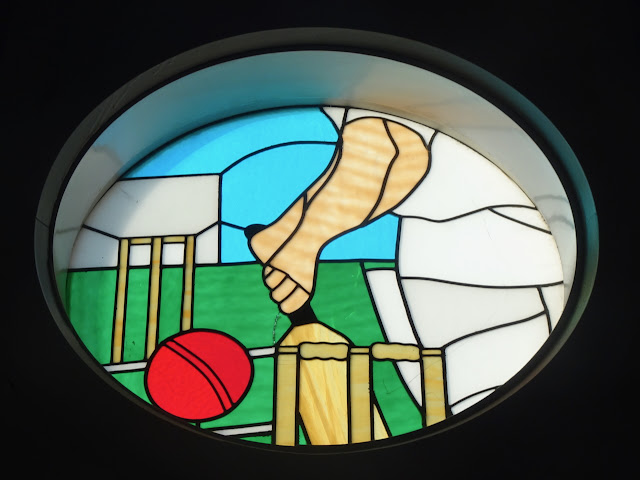Here is the tenth of 24 stained glass window designs on the Palace Pier which AI and I are using as inspiration for some of these BrightonBeach365 daily posts - see Stained Glass Window 1 for background. This image features, in close-up, a batsman’s arms and legs positioned next to a set of cricket stumps and bails. A bright red cricket ball, about to be hit, is shown close to the bat. The background includes a green field and blue sky, with an additional white section, probably a sight screen.
A limerick starter
A batsman once played by the sea,
With stumps by the pier and great glee.
He swung at a ball,
Gave Brighton his all
And bowled out a deckchair for three.
Beyond the Boundary (with apologies to the greatest cricket writer of all, C.L.R. James)
Brighton, summer, when the sea air is thick with sugar and salt, and the pier groans beneath the weight of tourists and time. It was here, just beyond the promenade, that the boy made his wicket from driftwood, balanced on a patch of shingle that passed for turf, and dreamed the game into being.
They called him Clem - short for Clement, though he bore little resemblance to that noble prime minister. Dark-skinned and limber, Clem bowled with a whipcord wrist and batted with the elegance of the ancients, though his audience was mostly seagulls and the occasional retiree resting on the bench with a copy of The Argus folded on their lap.
But this day was different. This day, a man in white trousers and a Panama hat approached from the pier, sipping tea from a paper cup like it was silver. He stood for a moment, watching Clem drive a cracked red ball through an upturned deckchair.
‘You ever played proper?’ the man asked, voice smooth like varnished mahogany.
Clem shook his head. ‘Just here.’
The man nodded slowly. ‘Then you’re overdue.’
That’s how it began. Brighton CC had lost two of their colts to summer jobs and one to sulking after being benched. They needed a number seven with sharp reflexes. Clem had never stood on grass so green or worn pads so stiff. But when the new ball swung like a gull in crosswind, he held his ground. And when the slow left-armer dropped one short, Clem pulled it into memory.
Yet it wasn’t only about cricket. Not on this coast. Not for Clem, who knew his grandfather had first disembarked here in ’48, wearing his Sunday best and carrying his bat like a suitcase. Not for Brighton, whose seafront had once denied men like him entry to clubs even as they cheered Caribbean tourists for ‘spicing up the season’. Not for England, where the empire was gone but not forgotten, not even under the shadow of the Pavilion.
That summer, Clem became more than a boy with a bat. He became a conversation. Old men leaned in to discuss his footwork. A local paper ran a headline - New Hope on the Boundary. And down by the pier, tourists took pictures of the match like it was theatre.
In the final game, as dusk rolled off the sea like steam from a kettle, Clem stood with his back to the setting sun. The bowler ran in - tall, wiry, South African. Clem stepped out. The ball pitched short, rose up, and Clem hooked. The ball soared, high over square leg, higher than the Pavilion roof, and for a moment it seemed to pause mid-air, suspended between sea and sky, past and present.
Then it landed - with a kerplunk - into the Channel.
That ball, they said, was still floating somewhere off the coast of Newhaven.
But Clem, barefoot in the shallows that evening, didn’t look for it. He knew it was not the ball that mattered, but the boundary it had crossed.

No comments:
Post a Comment